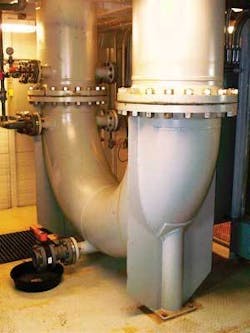In western US, ion-exchange technology is helping coalbed methane operators handle the large amounts of water produced with the gas.
Benefits of the technology include:
- Less environmental impact.
- Reduced regulatory-compliance paperwork.
- Lower future liability.
- Increased overall operations efficiency.
- Lower overall costs.
Waste water minimization
In recent years, the industry has undertaken commercial production of coalbed methane in the US and other countries. Large amounts of methane-rich gas are found in coal beds but production of much of this methane also requires producing large amounts of water.
This produced water may contain high levels of sodium (Na) that typically range from 500 to 1,200 ppm, total dissolved solids (TDS) ranging from 1,800 to 3,000 ppm, and carbonates (CO3). More stringent US federal and state water regulations now prohibit discharge of this water into the environment or its use for irrigation due to its high salt content.
Chemical treatment of this produced water can be cost-prohibitive. The industry, therefore, has sought other safe, affordable treatment alternatives to meet regulatory standards.
Since 2003, the Higgins Loop continuous-ion-exchange technology has provided an economical and efficient process for purifying produced water without generating hazardous wastes or large byproduct streams.
Water purification
A typical 7,000 bw/d Higgins Loop coalbed methane operation has a 20-ft × 60-ft footprint (Fig. 1). The process incorporates a continuous countercurrent ion exchange contactor for liquid phase separation of ionic components with solid exchange (I-X) resins.
The loop contactor is a vertical cylindrical loop about 36-ft high containing a packed bed of I-X resin that is separated into four operating zones by butterfly or loop valves. These operating zones (adsorption, regeneration, backwashing, and pulsing) function as four separate vessels.
Produced water containing high Na levels enters the adsorption zone within the loop where it contacts strong acid cation resin that loads Na ions in exchange for hydrogen (H) ions. Treated water leaves the loop with less than 10 mg/l. Na.
A CO2 evolution from the low-pH treated water removes the carbonate contained in the water, which is also harmful to the environment.
Na-loaded resin regeneration is concurrent with adsorption and takes place in the lower section of the loop (Fig. 2). The regeneration process uses either hydrochloric or sulfuric acid to produce a small, concentrated spent brine stream. Water rinses the regenerated resin before its reentry into the adsorption zone where acid removal from the resin pores takes place.
As resin in the upper layer of the adsorption zone becomes loaded with Na, momentary interruption in flows to the loop allow advancement of the resin bed (pulsing) through the loop in the opposite direction of liquid flow.
Liquid flow restarts after completion of the resin pulsing.
Treated water is slightly acidic due to its increased H-ion strength and is neutralized with limestone, which also increases its calcium concentration so that the water’s sodium adsorption ratio is less than 1.0. Spent brine containing removed Na ions has a density high enough for use as a kill fluid.
The Higgins Loop technology makes water laden with Na and CO3 safe for reintroduction to the environment. The byproduct water, which once was an environmental problem, now can be used by ranchers for irrigation, watering cattle, and for drinking water. The process generates no wastewater.
System maintenance primarily involves the pump, valve, and instruments, as well as the spent regenerant treatment and other routine equipment maintenance.
Maintenance costs as a percentage of equipment costs are lower than average for water treatment equipment.
Applications
In Montana and Wyoming, water from coal beds typically contains such high levels of sodium that its use for irrigation or release into nearby streams is not allowed.
To solve the problem of excessive discharge water, several companies, including Pinnacle Gas Resources Inc. of Sheridan, Wyo., installed a Higgins Loop to treat the water.
In southern Montana, about 150 miles southeast of Billings, Mont., the technology allows Pinnacle to replenish the flows of the Tongue River just downstream of the Tongue River Reservoir. The reservoir, river, and its tributaries are home to some of the state’s best fishing, with species including smallmouth bass, yellow perch, channel catfish, northern pike, and walleye.
The loop produces 240 gpm of water that meets or exceeds the ambient quality of the Tongue River and the standards established by the Montana Department of Environmental Quality. Pinnacle discharges this water directly into the river.
Just across the border in Wyoming, a pending Pinnacle project will use the Higgins Loop for treating 1,000-1,500 gpm, depending on the seasonal discharge limitations. This equates to about 2½ bbl of produced water/Mcf of natural gas extracted.
The safe, high-quality discharge from this operation potentially will benefit downstream irrigation of alfalfa and forage acreage.
The treating cost of the produced water with the Higgins Loop is the lowest among currently used technologies, and the primary costs are regenerant acid and spent-brine disposal. Spent-brine volumes generated equate to 1-2% of produced water treated, and the process consumes no fresh water beyond that in the spent brine.
Other technologies evaluated for this application include reverse osmosis and zeolite treatment, both of which generate at least five times more waste and have treatment costs of more than $0.40/bbl higher.
The Higgins Loop technology is a more effective ion exchange technology than fixed bed and other ion-exchange systems. It efficiently uses the resin capacity, needs less regenerant and fresh water, generates consistent product quality, and minimizes wastewater volumes. The technology offers expanded ranges for the use of ion-exchange resins and adsorbents in commercial separations.
The author
Rich Dennis is product manager for Severn Trent Services Inc.’s separation technologies that include the Higgins Loop ion exchange. He previous worked for DuPont, IMC, Advanced Separation Technologies, and TETRA Technologies. Dennis has a BS in chemical engineering from Lehigh University. He is a member of the AIChE, SME, and AWWA.





